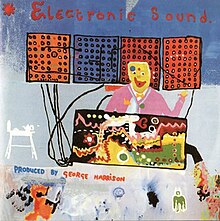| Electronic Sound | ||||
|---|---|---|---|---|
 | ||||
| Studio album by | ||||
| Released | 9 May 1969 | |||
| Recorded |
| |||
| Studio | ||||
| Genre | Avant-garde,[1][2] electronic music[3] | |||
| Length | 43:50 | |||
| Label | Zapple | |||
| Producer | George Harrison | |||
| George Harrison chronology | ||||
| ||||
Electronic Sound is the second studio album by the English rock musician George Harrison. Released in May 1969, it was the last of two LPs issued on the Beatles' short-lived Zapple record label, a subsidiary of Apple Records that specialised in the avant-garde. The album is an experimental work comprising two lengthy pieces performed on a Moog 3-series synthesizer. It was one of the first electronic music albums by a rock musician, made at a time when the Moog was usually played by dedicated exponents of the technology. Harrison subsequently introduced the Moog to the Beatles' sound, and the band featured synthesizer for the first time on their 1969 album Abbey Road.
Harrison began the project in Los Angeles, in November 1968, while he was producing sessions for his Apple Records artist Jackie Lomax. "No Time or Space" comprises an edit of a Moog demonstration given there by Bernie Krause, an American synthesizer exponent and Moog salesman. Once his own Moog system had arrived in England, in February 1969, Harrison recorded the second piece, "Under the Mersey Wall", at his home in Surrey. Krause later said that, with "No Time or Space", Harrison had recorded the studio demonstration without his knowledge and that it incorporated ideas he was due to include on his forthcoming album with Paul Beaver.
The cover artwork of Electronic Sound was taken from a painting by Harrison. The front cover shows Krause operating the Moog console, while the back depicts Derek Taylor's office at Apple and the pressures afflicting the company at the time.
The album has received an unfavourable response from many rock critics; these writers dismiss it as unfocused, unstructured, and consisting of random sounds. Some commentators and musicians judge it to be an adventurous work that displays the Moog's sonic potential at a time when the system was in its infancy. In the United States and Canada, the LP was pressed with the two tracks swapped around, leading to confusion regarding the identity of the pieces. The order was corrected for the album's CD release in 1996. The 2014 reissue includes essays by Kevin Howlett and electronica musician Tom Rowlands, along with Dhani Harrison's explanation of his father's artwork.
- ^ Inglis 2010, p. 20.
- ^ Badgley, Aaron (24 February 2017). "Spill Album Review: George Harrison – The Vinyl Collection". The Spill Magazine. Archived from the original on 5 March 2017. Retrieved 4 March 2017.
- ^ Cite error: The named reference
Ginell/AMwas invoked but never defined (see the help page).